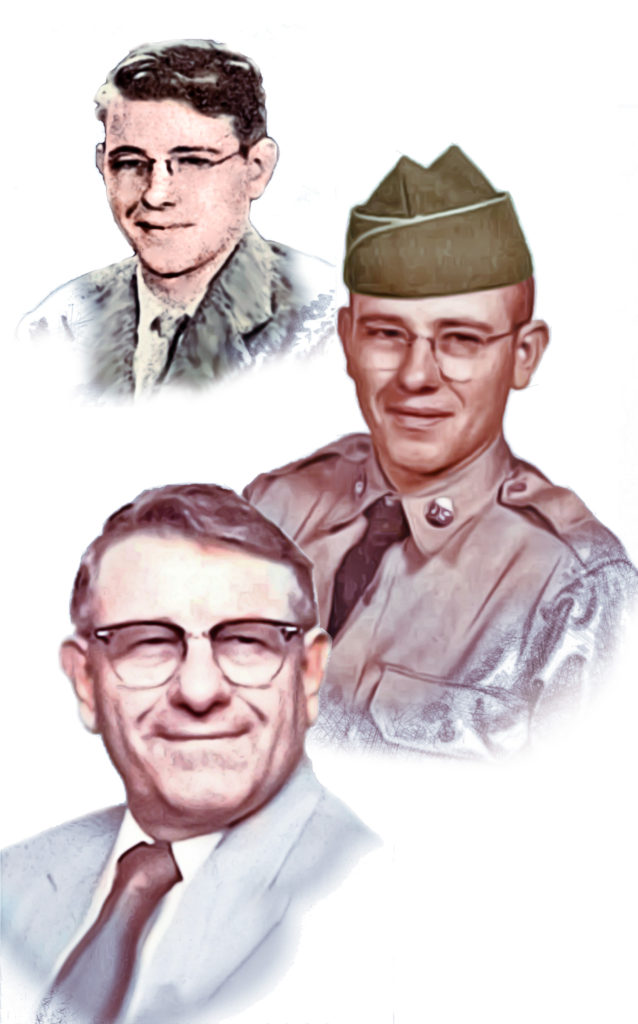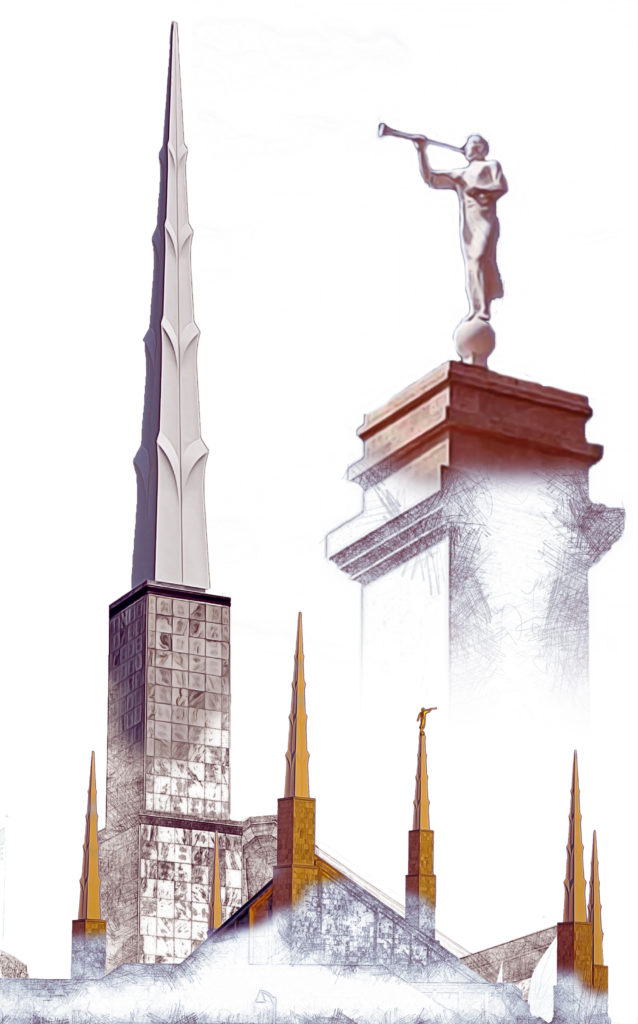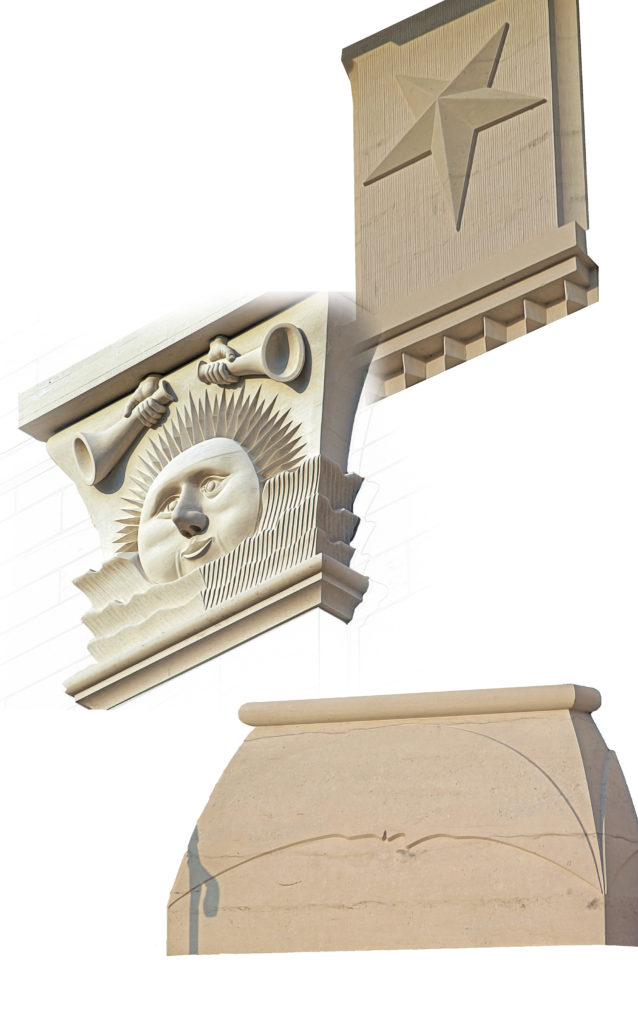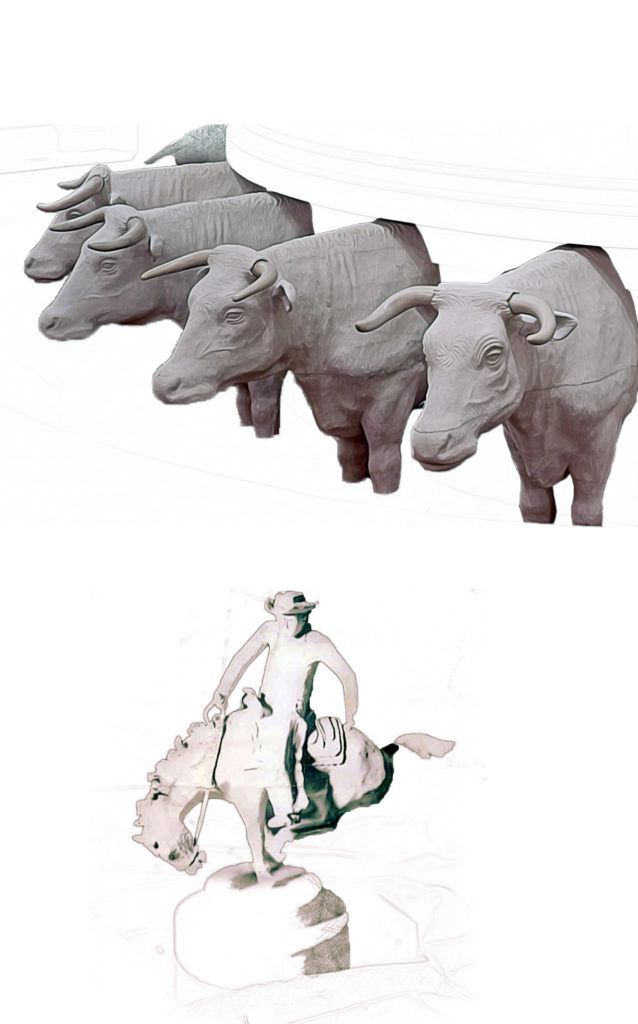SCULPTOR
LaVar Elof Wallgren
Studied At/With
Self-taught
Born
13 August 1932
Died
1 February 2004
“The most wonderful thing that ever happened to me is when I received a testimony of the Church. That glory and joy and, of course, the opportunity to create these statues is very humbling.”
-LaVar Wallgren
“The most wonderful thing that ever happened to me is when I received a testimony of the Church. That glory and joy and, of course, the opportunity to create these statues is very humbling.”
-LaVar Wallgren
Sculptor Forgotten by Time
It is not surprising by now that most of the Church, and many outside it, know of Cyrus Dallin, the non-member who sculpted the first statue. Millard Malin is less well known, but is still a known sculptor. Avard Fairbanks was very prolific with is work, and is very well remembered. And it seems everyone knows the Angel Moroni statues were sculpted by Karl Quilter. Look up any article on Angel Moroni statues and they will tell you all about those above.
But relegated to the side, to a mere by-line if he is mentioned at all, Is LaVar Wallgren. If he is remembered for anything, he is usually mentioned as having helped Brother Quilter cast his fiberglass statues.
This is unfortunate, for as you will see, LaVar Wallgren’s contributions to the Angel Moroni statues is as great or greater than that of most of the other sculptors.
Birth and Early Life
LaVar Wallgren was born 13 August 1932 in Midvale, Utah. He was the second of six sons[1]“Alice Jones Wallgren.” The Salt Lake Tribune, 11 May 1999. born to parents Elof Alexander Wallgren and Alice Jones Wallgren. His older brother, Wayne Gordon, died at the age of one year old, about a year before LaVar was born. LaVar was fond of art from an early age, mentioning his fondness for art in his senior quote in his high school yearbook.[2]“LaVar Elof Wallgren.” FamilySearch, The Church of Jesus Christ of Latter-Day Saints.
Korean War
LaVar was drafted into the Korean War in his early twenties. While serving in Japan during the war LaVar became determined to learn if the faith he had been brought up in was true. The experience was one he would later describe as being “glorious.”[3]Deseret News, Cala Byram. “A Life-Size Moroni.” Deseret News, Deseret News, 23 May 1998. After gaining a personal testimony of the Church, it became his life’s desire to want to do something to help build the kingdom of God on earth.[4]Hart, John L. “Statues Sculpted in Fiberglass.” Deseret News, 4 Sept. 1983, pp. 8–13.
On-the-job Training
Sometime after the end of his service, Wallgren went to work construction, perhaps thinking that one day it might give him the opportunity to work for the Church in that field. Despite being involved in construction, he received a strong impression that he would eventually work for a specific company building fiberglass boats. Not to long after he became sick with rheumatic fever. His doctor pressured him to change careers, at which point, he found himself working in the boatyard he had been impressed to work for years before.[5]Hart, John L. “Statues Sculpted in Fiberglass.” Deseret News, 4 Sept. 1983, pp. 8–13.
Having grown up as a self-taught artist, it was not long before he began to turn his thoughts to ways he could apply the same fiberglass methods he was learning at the boatyard to art. Each job he had after that left him with new training an experience that would carry him to his eventual goal.[6]Hart, John L. “Statues Sculpted in Fiberglass.” Deseret News, 4 Sept. 1983, pp. 8–13.
Building the Business
When Karl Quilter approached him about collaborating on casting sculptures in fiberglass, both of them already had the necessary background, understanding, and experience necessary to make the creative leap. What would follow was a lifelong partnership between Quilter, an artist and industrial designer by training, and Wallgren, an artist at heart and a master with fiberglass.[7]Hart, John L. “Statues Sculpted in Fiberglass.” Deseret News, 4 Sept. 1983, pp. 8–13.
As they began work on their first projects, Quilter’s statue “The Release of Aphrodite,”[8]Dibble, Gregory. “Paper Shortage May Chalk up a Gain for Artist.” The Salt Lake Tribune, 30 Dec. 1973, p. E3. and the new tower spires for the Assembly hall[9]“New Spires Brighten Old Hall,” Church News, 18 July 1981; also, Roe, Frederick Robert 1920-. Angels: Moroni and his associates / Fred Roe [Bountiful, Utah]: The Author, 1992 May 1992 printing, p 49. (accessed: 5 September 5 2018). being just two examples, they were able to develop a unity necessary to quickly and seamlessly go from concept to finished product. Wallgren commented on the necessity of their close working partnership when he said that “You may have to change the artwork so the mold will come free. To make these adjustments, you must have friendship and unity between two artists.”[10]Hart, John L. “Statues Sculpted in Fiberglass.” Deseret News, 4 Sept. 1983, pp. 8–13.
Wallgren and Quilter did all their work together under a single roof. Karl would sculpt the statue’s in clay on site, LaVar would build seems into the statue for the mold. The mold would be created, and the fiberglass resin pieces cast. The pieces were sandblasted and assembled. All was done onsite, unlike previous sculptors, who would send their molds cross country to a foundry to be cast.[11]Hart, John L. “Statues Sculpted in Fiberglass.” Deseret News, 4 Sept. 1983, pp. 8–13.




Work for the Church
Assembly Hall
One of the first Jobs that Wallgren’s Studio did was the spires on the assembly hall. The original wooden spires were beginning to rot, and Wallgren’s company made replacement spires for the hall’s towers out of fiberglass that were replicas of the originals.[12]“New Spires Brighten Old Hall”.; also, Roe
Spires
Another early project the pair of Quilter and Wallgren worked on at Wallgren’s Studios were the white spires seen on each of the “standard plan” temples built in the 1980’s that had the 6 detached towers with white spires atop them.[13]Hart, John L. “Statues Sculpted in Fiberglass.” Deseret News, 4 Sept. 1983, pp. 8–13.
Nauvoo
LaVar was asked, along with friend and business partner James Dell Morris[14]James Dell Morris also has a history with Angel Moroni statues, though a smaller one than other artists in this book. Like Quilter, Morris submitted a statue for consideration for the Washington D.C. Temple, both of them losing out to Fairbanks’s Submission. Morris also signed the bottom of Quilter’s 1985 Angel Moroni Statue as an assistant. to recreate the carved stone needed for the reconstruction of the Nauvoo Illinois Temple.[15]Moore, Carrie A. “Resurrecting a Temple.” Deseret News, Deseret News, 2 July 2000, This magnificent feat was accomplished through examining the remains of the last existing stones and carving segments of the original temple, then comparing these actual fragments and pieces to written descriptions and the few remaining plans from the temple.[16]Moore, Carrie A. “Resurrecting a Temple.” Deseret News, Deseret News, 2 July 2000, Wallgren and Morris then recreated the needed stones in fiberglass, creating a pattern for each carving. The patterns were then shipped to the stone quarry. At the Quarry, the patterns were laser scanned, and a CNC machine was used to remove most of the stone for the new carved pieces. After the rough machining, the rest of the stone was shaped and removed by skilled craftsmen.[17]Moore, Carrie A. “Resurrecting a Temple.” Deseret News, Deseret News, 2 July 2000,
Moonstones and Starstones
For the Moonstones and Star Stones, existing complete pieces were available from which measurements could be made, and new fiberglass patterns could be created.[18]Moore, Carrie A. “Resurrecting a Temple.” Deseret News, Deseret News, 2 July 2000,
Sunstones
The Sunstones of the Nauvoo Temple created a bigger challenge for the duo. Existing sunstones were degraded enough that details were difficult to see. Remaining fragments did not match up with descriptions and other available information. In the end they made the stones as close as possible.[19]Moore, Carrie A. “Resurrecting a Temple.” Deseret News, Deseret News, 2 July 2000,
Oxen
The biggest task by far for the pair was the oxen for the temple. They began with a pair of oxen at This is the Place State Park. The y took numerous photos of the two oxen, combined with diagrams of muscle structure. They applied their reference material to descriptions of the original Stone oxen for the temple, and only four remaining stone fragments. The ears and horns of the oxen were created as separate pieces in order to make sculpting easier for the craftsmen. The horns are polished, unlike the rest of the oxen, which has a matte finish.[20]Moore, Carrie A. “Resurrecting a Temple.” Deseret News, Deseret News, 2 July 2000,
As each of the oxen, moonstones, starstones, and sunstones was hand finished, each has a slightly different look, making each one a unique creation reflecting the skill of the individual sculptor.
Angel Moroni
Brother Wallgren had the opportunity to have his name attached to two of the Angel Moroni statues used on temples. The first is Karl Quilter’s 1982 statue, of which LaVar Wallgren is a co-signer.
The second statue was one all his own.
Though not classically trained as an artist or sculptor, Wallgren was asked to come up with a life-size Angel Moroni for the smaller temples, one that would be smaller than the other molds already in use. He knew upon being asked that it would have a scroll, like the angel mentioned in Revelation 14:6-7. He sketched then sculpted the new statue, which was approved by the First Presidency. The new statue was 5’ 11”, with the face of a much younger man than the other statues. It was originally intended to be white, rather than gold leafed, but the only white statue placed, on Monticello Utah Temple, proved to be difficult to see against the clouds. The Monticello temple statue was then replaced with the 7-foot Quilter Statue. The five remaining statues were given gold leaf before being placed on temples.[21]Deseret News, Cala Byram. “A Life-Size Moroni.” Deseret News, Deseret News, 23 May 1998.
Famous Works by LaVar Wallgren
| Assembly hall tower cupolas | Salt Lake Temple Square | 1981 |
| Angel Moroni, 7 ft. (Assisting Karl Quilter) | 90+ Temples worldwide | 1982 |
| Angel Moroni 5 ft. 10 in | 5 Temples worldwide, Church History Museum Storage | 1997 |
| Nauvoo Temple Oxen, Star Stones, Moon Stones, Sun Stones (With J. Dell Morris) | Nauvoo, Illinois | 1999 |
Chapter 4 Navigation
Related Articles
References
| ↑1 | “Alice Jones Wallgren.” The Salt Lake Tribune, 11 May 1999. |
|---|---|
| ↑2 | “LaVar Elof Wallgren.” FamilySearch, The Church of Jesus Christ of Latter-Day Saints. |
| ↑3, ↑21 | Deseret News, Cala Byram. “A Life-Size Moroni.” Deseret News, Deseret News, 23 May 1998. |
| ↑4, ↑5, ↑6, ↑7, ↑10, ↑11, ↑13 | Hart, John L. “Statues Sculpted in Fiberglass.” Deseret News, 4 Sept. 1983, pp. 8–13. |
| ↑8 | Dibble, Gregory. “Paper Shortage May Chalk up a Gain for Artist.” The Salt Lake Tribune, 30 Dec. 1973, p. E3. |
| ↑9 | “New Spires Brighten Old Hall,” Church News, 18 July 1981; also, Roe, Frederick Robert 1920-. Angels: Moroni and his associates / Fred Roe [Bountiful, Utah]: The Author, 1992 May 1992 printing, p 49. (accessed: 5 September 5 2018). |
| ↑12 | “New Spires Brighten Old Hall”.; also, Roe |
| ↑14 | James Dell Morris also has a history with Angel Moroni statues, though a smaller one than other artists in this book. Like Quilter, Morris submitted a statue for consideration for the Washington D.C. Temple, both of them losing out to Fairbanks’s Submission. Morris also signed the bottom of Quilter’s 1985 Angel Moroni Statue as an assistant. |
| ↑15, ↑16, ↑17, ↑18, ↑19, ↑20 | Moore, Carrie A. “Resurrecting a Temple.” Deseret News, Deseret News, 2 July 2000, |
